碳化钛中化合碳含量分析方案的设计
碳化钛中化合碳含量分析方案的设计

0000本科毕业设计(论文)摘要摘要通过文献检索,未见到针对碳化钛中化合碳分析测定的研究报道。
本文设计用到碳硫仪燃烧气体容量法来测量碳化钛中的化合碳,由于在碳化钛中存在少量的游离碳,测量时会对化合碳的分析进行干扰,因此本文设计采用高温燃烧来分离游离碳,再次残留取样测量化合碳,又因为碳硫仪测量碳时对于助溶剂,用量及配比上的选择,所以本文对碳硫仪燃烧气体容量法所用助溶剂进行了设计。
通过这次设计确定碳化钛中化合碳分析测定的参数的大致范围,建立了化合碳测定分析的方案,为研究建立化合碳分析方法奠定了基础。
关键字碳化钛,化合碳,设计,分析ABSTRACTThrough the literature retrieval, not seen for carbonation in titanium compound carbon determination research report. This paper used design capacity method to measure the gas combustion of titanium carbide compound carbo n, because in carbonization titanium in small amounts of free carbon, measurement of compound carbon when the analysis on interference, so this paper design of high temperature burning to separate free carbon, and once again the compound carbon residue sampling measurement, and because carbon sulfur instrument for measuring carbon when reagent, the dosage and ratio of the choice, so this paper burning sulfur gases carbon instrument capacity method was used to help solvent design.This design determine titanium carbide in the determination of the compound carbon the Outlines of the process parameters, establishes the combined carbon analysis plan, for the study and establish the compound carbon analysis method lay the foundation.Key words titanium carbide, compound carbon, design, analysis目录摘要 ........................................................................................................................... I ABSTRACT .................................................................................................................II1 绪论 (3)1.1课题背景 (3)1.1.1碳化钛的性能及应用 (3)1.1.2碳化钛的工艺制备和组成分析 (3)1.1.3研究的目的及意义 ....................................................... 错误!未定义书签。
碳化钛分析方法的实验研究
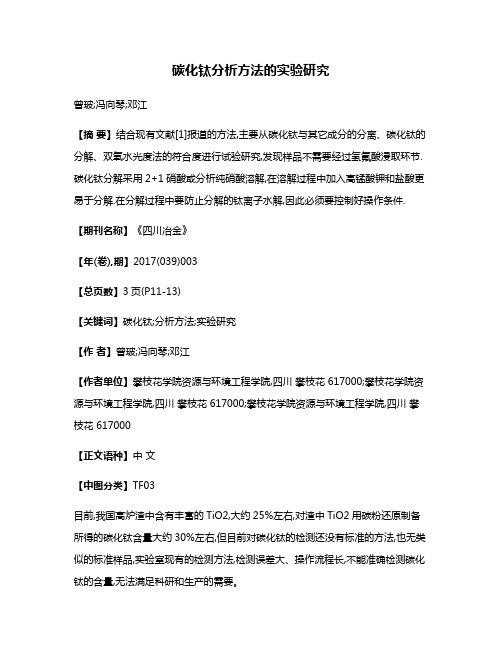
碳化钛分析方法的实验研究曾玻;冯向琴;邓江【摘要】结合现有文献[1]报道的方法,主要从碳化钛与其它成分的分离、碳化钛的分解、双氧水光度法的符合度进行试验研究,发现样品不需要经过氢氟酸浸取环节.碳化钛分解采用2+1硝酸或分析纯硝酸溶解,在溶解过程中加入高锰酸钾和盐酸更易于分解.在分解过程中要防止分解的钛离子水解,因此必须要控制好操作条件.【期刊名称】《四川冶金》【年(卷),期】2017(039)003【总页数】3页(P11-13)【关键词】碳化钛;分析方法;实验研究【作者】曾玻;冯向琴;邓江【作者单位】攀枝花学院资源与环境工程学院,四川攀枝花 617000;攀枝花学院资源与环境工程学院,四川攀枝花 617000;攀枝花学院资源与环境工程学院,四川攀枝花 617000【正文语种】中文【中图分类】TF03目前,我国高炉渣中含有丰富的TiO2,大约25%左右,对渣中TiO2用碳粉还原制备所得的碳化钛含量大约30%左右,但目前对碳化钛的检测还没有标准的方法,也无类似的标准样品,实验室现有的检测方法,检测误差大、操作流程长,不能准确检测碳化钛的含量,无法满足科研和生产的需要。
从文献[1]可知:(1)碳化渣样品中Ti形式基本都为TiC,只存在极少的TiN,TiN的存在对TiC含量测定结果的影响可以忽略不计;(2)采用了(1+ 5)硫酸80 m L和氢氟酸10 m L,低温加热浸取30 min,再进行过滤等这一系列繁琐、冗长操作过程是多余的,且氢氟酸使用不安全,对人体有危害;(3)后序采用纯硝酸分解TiC,试验发现分解不够彻底; (4)连同滤纸进行分解,存在一定包裹现象,而且对定容体积也有一定程度的影响;(5)该文献所例举的实例数据TiC的含量小于20%,对更高含量TiC的测定是否能满足,需要进一步试验验证。
因此,通过该文献方法来检测碳化渣中TiC的含量有待进一步完善和改进。
针对上述存在的问题,提出了一种碳化渣中TiC的分析方法,有效地解决了所存在的问题,建立了一种碳化渣中TiC的分析方法,合理删除了对人体伤害较大、使用极其不安全的氢氟酸浸取环节,在后序的硝酸分解中引入了两种廉价而且安全的试剂即高锰酸钾和盐酸,使TiC分解更彻底,分析准确度提高,大大缩短了操作流程,并用双氧水光度法、对这样高的碳化钛含量的检测结果符合度进行了试验验证,从而扩大了方法的测定范围,方法适用范围更广。
ZIF-8@酚醛树脂及ZIF-8@钛凝胶碳化制备核壳多孔复合碳及其吸附性能的研究论文设计
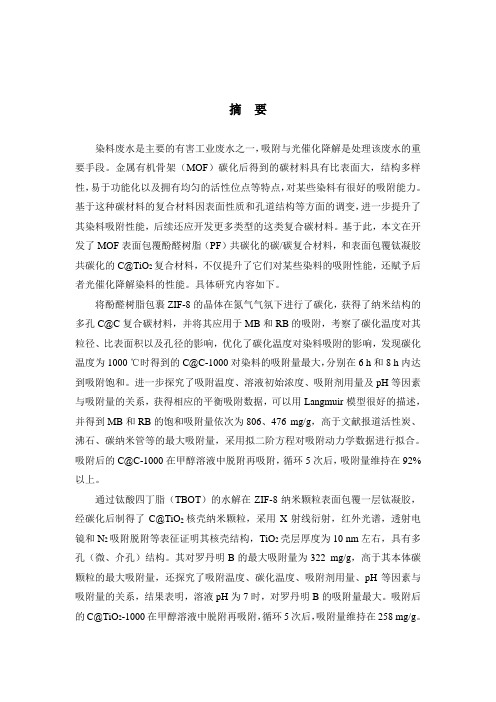
摘要染料废水是主要的有害工业废水之一,吸附与光催化降解是处理该废水的重要手段。
金属有机骨架(MOF)碳化后得到的碳材料具有比表面大,结构多样性,易于功能化以及拥有均匀的活性位点等特点,对某些染料有很好的吸附能力。
基于这种碳材料的复合材料因表面性质和孔道结构等方面的调变,进一步提升了其染料吸附性能,后续还应开发更多类型的这类复合碳材料。
基于此,本文在开发了MOF表面包覆酚醛树脂(PF)共碳化的碳/碳复合材料,和表面包覆钛凝胶共碳化的C@TiO2复合材料,不仅提升了它们对某些染料的吸附性能,还赋予后者光催化降解染料的性能。
具体研究内容如下。
将酚醛树脂包裹ZIF-8的晶体在氮气气氛下进行了碳化,获得了纳米结构的多孔C@C复合碳材料,并将其应用于MB和RB的吸附,考察了碳化温度对其粒径、比表面积以及孔径的影响,优化了碳化温度对染料吸附的影响,发现碳化温度为1000 ℃时得到的C@C-1000对染料的吸附量最大,分别在6 h和8 h内达到吸附饱和。
进一步探究了吸附温度、溶液初始浓度、吸附剂用量及pH等因素与吸附量的关系,获得相应的平衡吸附数据,可以用Langmuir模型很好的描述,并得到MB和RB的饱和吸附量依次为806、476 mg/g,高于文献报道活性炭、沸石、碳纳米管等的最大吸附量,采用拟二阶方程对吸附动力学数据进行拟合。
吸附后的C@C-1000在甲醇溶液中脱附再吸附,循环5次后,吸附量维持在92%以上。
通过钛酸四丁脂(TBOT)的水解在ZIF-8纳米颗粒表面包覆一层钛凝胶,经碳化后制得了C@TiO2核壳纳米颗粒,采用X射线衍射,红外光谱,透射电镜和N2吸附脱附等表征证明其核壳结构,TiO2壳层厚度为10 nm左右,具有多孔(微、介孔)结构。
其对罗丹明B的最大吸附量为322 mg/g,高于其本体碳颗粒的最大吸附量,还探究了吸附温度、碳化温度、吸附剂用量、pH等因素与吸附量的关系,结果表明,溶液pH为7时,对罗丹明B的吸附量最大。
碳化钛粉中总碳、游离碳的测定
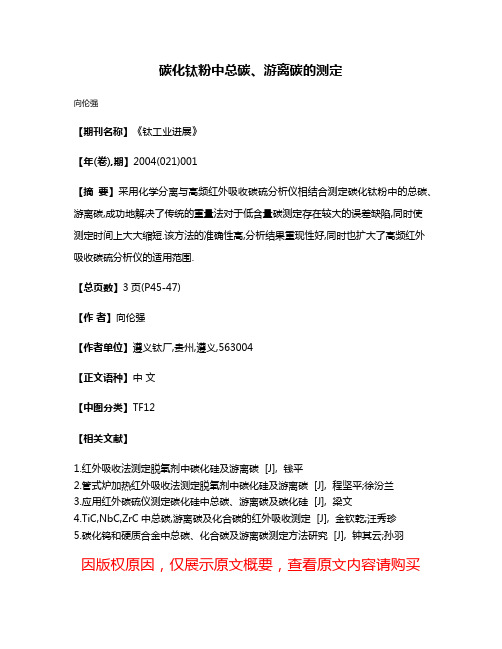
碳化钛粉中总碳、游离碳的测定
向伦强
【期刊名称】《钛工业进展》
【年(卷),期】2004(021)001
【摘要】采用化学分离与高频红外吸收碳硫分析仪相结合测定碳化钛粉中的总碳、游离碳,成功地解决了传统的重量法对于低含量碳测定存在较大的误差缺陷,同时使测定时间上大大缩短.该方法的准确性高,分析结果重现性好,同时也扩大了高频红外吸收碳硫分析仪的适用范围.
【总页数】3页(P45-47)
【作者】向伦强
【作者单位】遵义钛厂,贵州,遵义,563004
【正文语种】中文
【中图分类】TF12
【相关文献】
1.红外吸收法测定脱氧剂中碳化硅及游离碳 [J], 钱平
2.管式炉加热红外吸收法测定脱氧剂中碳化硅及游离碳 [J], 程坚平;徐汾兰
3.应用红外碳硫仪测定碳化硅中总碳、游离碳及碳化硅 [J], 梁文
4.TiC,NbC,ZrC中总碳,游离碳及化合碳的红外吸收测定 [J], 金钦乾;汪秀珍
5.碳化钨和硬质合金中总碳、化合碳及游离碳测定方法研究 [J], 钟其云;孙羽
因版权原因,仅展示原文概要,查看原文内容请购买。
碳化钛复合材料的制备及性能研究

1前言鉴于碳化钛具有熔点高、硬度高、抗热震性好及良好的耐热冲击性等各项优异的性能,因而作为难熔碳化物普遍应用于切削刀具、耐磨材料、坩埚和工业机械配件等众多领域[1,2]。
碳化钛粉末一般采用碳热还原法进行制备,以二氧化钛或钛作为钛源和炭黑等混合均匀后,在真空碳(石墨)管炉中于高温下反应即可生成。
也可应用其他制备方法,如高温自蔓延法等[3]。
碳化钛陶瓷材料的制备方法主要有:机械合金化法、原位合成法、高温自蔓延法、热喷涂法等等[3-7]。
在TiC陶瓷材料中添加金属材料组分,不仅可以保留陶瓷固有的耐磨性、高硬度、高强度及抗氧化等特性,还具有了金属组分的延展性,使复合材料的韧性得以提升[1,8]。
因此,本实验添加WC作为补强增韧相,粘结相金属Ni、Co和Mo于TiC基体材料中,采用真空烧结工艺和热压烧结工艺制备了碳化钛陶瓷李少峰(宁波东联密封件有限公司,宁波,315191)扫描电镜(SEM)对试样的表观形貌与断口形貌进行了观察,检测了其力学性能并分析了抗氧化性能。
结果显示:采用不同烧结工艺制备的碳化钛复合材料的力学性能及微观结构有较大差别,热压烧结工艺制备的试样各项性能较优,且试样的断裂面显微组织细密、晶界分布明显、裂纹扩张路线多样变化且走向清晰。
力学性能分别为:弯曲强度1139MPa,断裂韧性9.8MPa·m1/2,维氏硬度21.7GPa,相对密度99.2%。
在设定的条件氧化2h后,900℃时热压烧结制备的试样表面生成了对基体没有保护效用的非保护性氧化膜;而1150℃时试样表面形成了一层致密的对基体具有保护效果的保护性氧化膜。
碳化钨;复合材料;真空烧结;热压烧结;抗氧化性能:宁波市科技创新2025重大专项(2020Z112)。
(1983-),男,硕士,高级工程师,主要从事结构陶瓷研究。
Email:********************。
. All Rights Reserved.复合材料。
选用扫描电镜(SEM )察看了复合材料的表观形貌与断口形貌,分别检测了其力学性能,并对热压烧结工艺制备的碳化钛复合材料的抗氧化性能进行了研究。
碳化钛中全钛的检测方案的设计
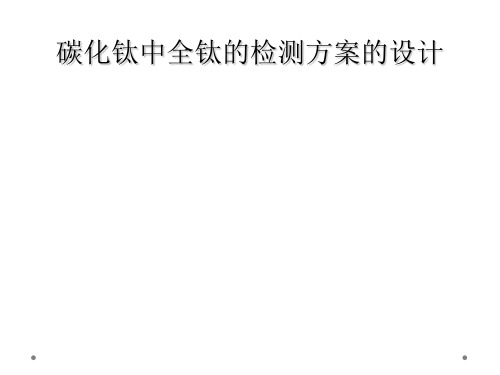
部分氢氧化物产生沉淀时的PH值
酸度 pH<0.47
还原方案的设计
还原参数列表
方案 设计
滴定方案的设计
滴定溶液的选择
方案 设计
硫酸高铁铵溶液滴定法适用于钒含量很低时的样 品检测,效果明显,操作也较为简单,在本文中选 取硫酸高铁铵作为标准滴定溶液,硫氰酸铵作为指 示剂。
滴定方案的设计
样品钛含量:50%~80%
称样量过大:滴定时间延长,Ti3+与空气中的氧气反应
称样量过小:称样过程中产生误差影响测定结果
称 样 量:0.1000g~0.1500g
分解方案的设计
酸溶:工作的温度低、操作简便,而且带入其他的阳离子 的量少得多,更适用于微量元素含量较低的样品的分析
碱熔:能够彻底分解样品中的各种矿物
碳化钛中全钛的检测方案的设计
碳化钛中全钛的检测方案的设计
课题背景 原理分析 方案设计 精密度实验方案设计 回收率实验方案设计 方案流程图 方案评价
课题 背景
碳化钛产品中的全钛的含量是对所研制产品 质量评价一个重要指标,目前国内外的很少有 关于碳化钛中全钛的检测方面的报道。通过对 碳化钛中全钛的检测方案的设计,为顺利地建 立起碳化钛中全钛含量分析方法研究打好基础 ,提供参考,从而指导科研生产。通过该课题 的研究实施,作为一名学生能多方面了解钛的 分析方法,掌握方案设计的基本思路,对今后 从事工作和科学研究打下良好的基础。
指示剂
溶液 加 热
溶液
铝片:3~5g 还原
饱和的碳酸氢钠 产生CO2
溶液 滴定
硫酸高铁铵 0.033~0.083mol/l
红色溶液
设计方案的科学性 设计方案的安全性 设计方案的可行性
矿产
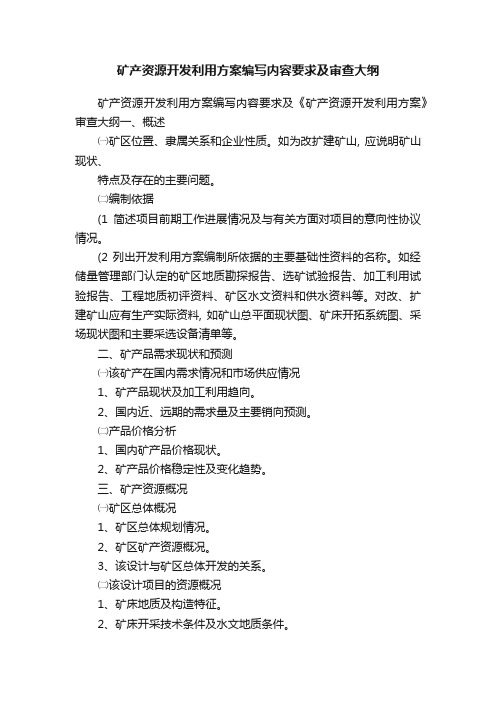
矿产资源开发利用方案编写内容要求及审查大纲
矿产资源开发利用方案编写内容要求及《矿产资源开发利用方案》审查大纲一、概述
㈠矿区位置、隶属关系和企业性质。
如为改扩建矿山, 应说明矿山现状、
特点及存在的主要问题。
㈡编制依据
(1简述项目前期工作进展情况及与有关方面对项目的意向性协议情况。
(2 列出开发利用方案编制所依据的主要基础性资料的名称。
如经储量管理部门认定的矿区地质勘探报告、选矿试验报告、加工利用试验报告、工程地质初评资料、矿区水文资料和供水资料等。
对改、扩建矿山应有生产实际资料, 如矿山总平面现状图、矿床开拓系统图、采场现状图和主要采选设备清单等。
二、矿产品需求现状和预测
㈠该矿产在国内需求情况和市场供应情况
1、矿产品现状及加工利用趋向。
2、国内近、远期的需求量及主要销向预测。
㈡产品价格分析
1、国内矿产品价格现状。
2、矿产品价格稳定性及变化趋势。
三、矿产资源概况
㈠矿区总体概况
1、矿区总体规划情况。
2、矿区矿产资源概况。
3、该设计与矿区总体开发的关系。
㈡该设计项目的资源概况
1、矿床地质及构造特征。
2、矿床开采技术条件及水文地质条件。
矿产

矿产资源开发利用方案编写内容要求及审查大纲
矿产资源开发利用方案编写内容要求及《矿产资源开发利用方案》审查大纲一、概述
㈠矿区位置、隶属关系和企业性质。
如为改扩建矿山, 应说明矿山现状、
特点及存在的主要问题。
㈡编制依据
(1简述项目前期工作进展情况及与有关方面对项目的意向性协议情况。
(2 列出开发利用方案编制所依据的主要基础性资料的名称。
如经储量管理部门认定的矿区地质勘探报告、选矿试验报告、加工利用试验报告、工程地质初评资料、矿区水文资料和供水资料等。
对改、扩建矿山应有生产实际资料, 如矿山总平面现状图、矿床开拓系统图、采场现状图和主要采选设备清单等。
二、矿产品需求现状和预测
㈠该矿产在国内需求情况和市场供应情况
1、矿产品现状及加工利用趋向。
2、国内近、远期的需求量及主要销向预测。
㈡产品价格分析
1、国内矿产品价格现状。
2、矿产品价格稳定性及变化趋势。
三、矿产资源概况
㈠矿区总体概况
1、矿区总体规划情况。
2、矿区矿产资源概况。
3、该设计与矿区总体开发的关系。
㈡该设计项目的资源概况
1、矿床地质及构造特征。
2、矿床开采技术条件及水文地质条件。
矿产

矿产资源开发利用方案编写内容要求及审查大纲
矿产资源开发利用方案编写内容要求及《矿产资源开发利用方案》审查大纲一、概述
㈠矿区位置、隶属关系和企业性质。
如为改扩建矿山, 应说明矿山现状、
特点及存在的主要问题。
㈡编制依据
(1简述项目前期工作进展情况及与有关方面对项目的意向性协议情况。
(2 列出开发利用方案编制所依据的主要基础性资料的名称。
如经储量管理部门认定的矿区地质勘探报告、选矿试验报告、加工利用试验报告、工程地质初评资料、矿区水文资料和供水资料等。
对改、扩建矿山应有生产实际资料, 如矿山总平面现状图、矿床开拓系统图、采场现状图和主要采选设备清单等。
二、矿产品需求现状和预测
㈠该矿产在国内需求情况和市场供应情况
1、矿产品现状及加工利用趋向。
2、国内近、远期的需求量及主要销向预测。
㈡产品价格分析
1、国内矿产品价格现状。
2、矿产品价格稳定性及变化趋势。
三、矿产资源概况
㈠矿区总体概况
1、矿区总体规划情况。
2、矿区矿产资源概况。
3、该设计与矿区总体开发的关系。
㈡该设计项目的资源概况
1、矿床地质及构造特征。
2、矿床开采技术条件及水文地质条件。
- 1、下载文档前请自行甄别文档内容的完整性,平台不提供额外的编辑、内容补充、找答案等附加服务。
- 2、"仅部分预览"的文档,不可在线预览部分如存在完整性等问题,可反馈申请退款(可完整预览的文档不适用该条件!)。
- 3、如文档侵犯您的权益,请联系客服反馈,我们会尽快为您处理(人工客服工作时间:9:00-18:30)。
矿产资源开发利用方案编写内容要求及审查大纲
矿产资源开发利用方案编写内容要求及《矿产资源开发利用方案》审查大纲一、概述
㈠矿区位置、隶属关系和企业性质。
如为改扩建矿山, 应说明矿山现状、
特点及存在的主要问题。
㈡编制依据
(1简述项目前期工作进展情况及与有关方面对项目的意向性协议情况。
(2 列出开发利用方案编制所依据的主要基础性资料的名称。
如经储量管理部门认定的矿区地质勘探报告、选矿试验报告、加工利用试验报告、工程地质初评资料、矿区水文资料和供水资料等。
对改、扩建矿山应有生产实际资料, 如矿山总平面现状图、矿床开拓系统图、采场现状图和主要采选设备清单等。
二、矿产品需求现状和预测
㈠该矿产在国内需求情况和市场供应情况
1、矿产品现状及加工利用趋向。
2、国内近、远期的需求量及主要销向预测。
㈡产品价格分析
1、国内矿产品价格现状。
2、矿产品价格稳定性及变化趋势。
三、矿产资源概况
㈠矿区总体概况
1、矿区总体规划情况。
2、矿区矿产资源概况。
3、该设计与矿区总体开发的关系。
㈡该设计项目的资源概况
1、矿床地质及构造特征。
2、矿床开采技术条件及水文地质条件。
